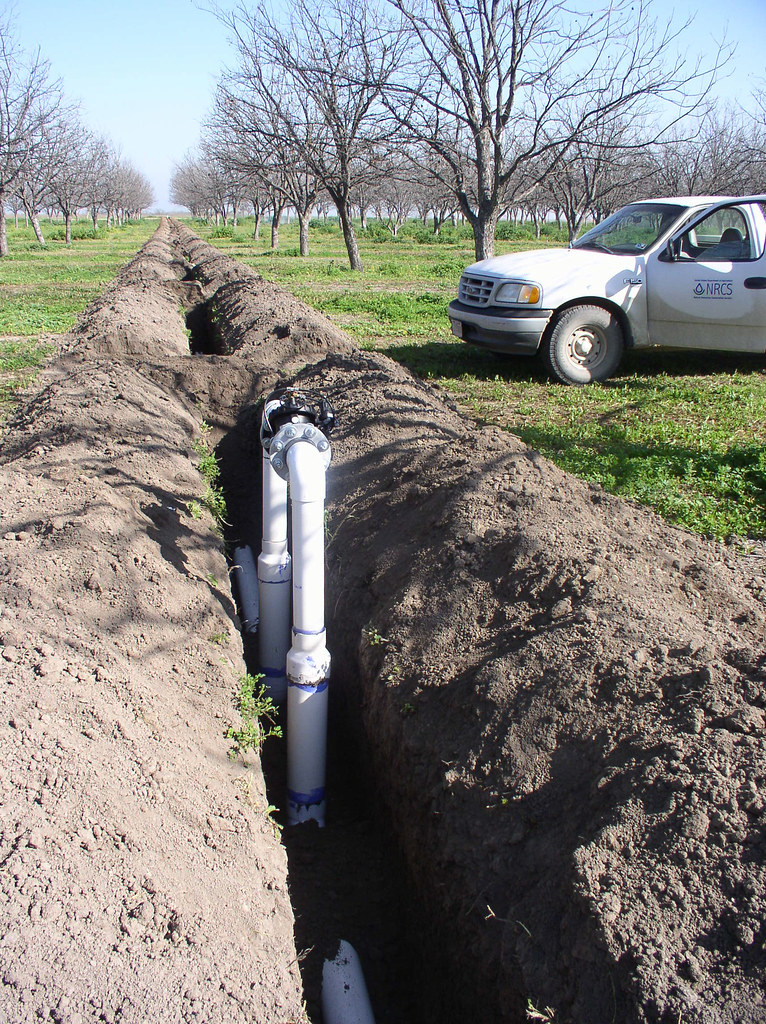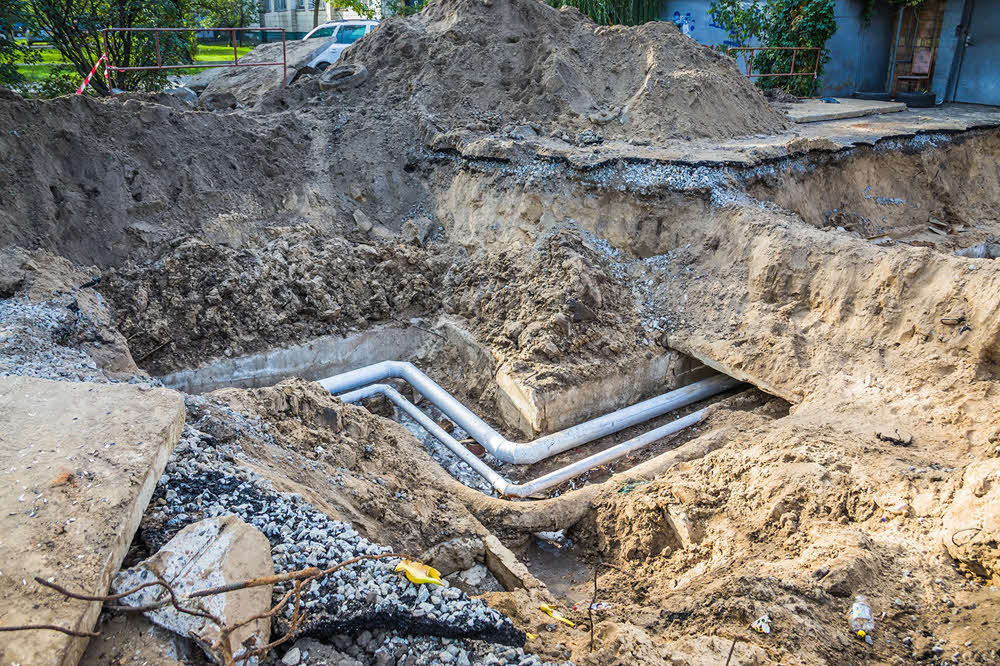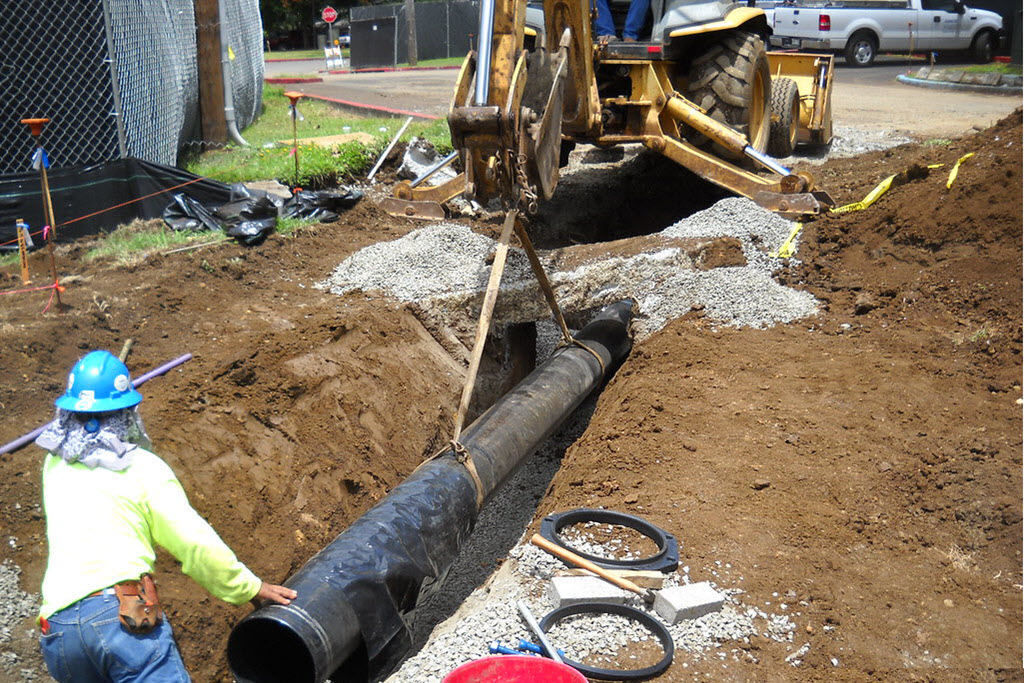Trenching Water Line Servicesin Rochester MI
Trenching for Water Lines to Ensure Reliable Water Flow
We Are Locally Owned & Operated For Over 37 Years
Contact Us Today!
We Serve Businesses In And Around The Following Cities:
About Trenching Water Line Services
A Comprehensive Guide to Trench for Water Line in Rochester
Once a fringe solution, the trench for water line has increasingly become a go-to methodology for water main installation in Rochester. Far from being simply a novel concept, this procedure provides a myriad of advantages, both to commercial establishments and to the local community. It is widely recognized for its cost-effectiveness, minimal environmental impact, and swift deployment – a testament to the city’s commitment to the preservation of old architecture and infrastructure while grappling with the practical challenges of urban growth.
Understanding Trench for Water Line
The process of trench for water line, also known as trenchless technology, is essentially about installing water service line without the need for extensive digging or open cut trenches. It helps in running a new water line under driveways, sidewalks, landscaping, or buildings while causing minimum disruption to the surfaces above.
Typically, it involves creating a small access hole where the pipe starts and another where the pipe ends. Trenchless machinery then pulls the new pipe through the old one, breaking the existing pipe apart while simultaneously replacing it with a new one. This method, even though it might sound complex, proffers several benefits.
The Trenchless Advantage
Implementing trench for water line in commercial properties saves time, a valuable commodity in any business, and minimises the disruption often associated with traditional digging methods. The trenchless method can often have water service restored far quicker than traditional methods. It significantly reduces the risks to underground infrastructure and nearby structures, thus contributing to a safer work environment.
Another important advantage is the cost-efficiency. With the reduced need for excavation and the swift completion time, the trenchless method is often more economical than traditional water line installation methods. Moreover, the method is environmentally friendlier as it offers lower carbon emissions with less disruption of natural habitats.
Real-World Applications in Rochester
A broad spectrum of businesses across Rochester has adopted the trench for water line solution, owing to these undeniable benefits. For instance, consider the case of several historical buildings in the city, where digging a trench would threaten the structural integrity of centuries-old foundations. Through trenchless technology, their water lines were updated without putting the city’s rich architecture at risk.
Regularly, companies such as D&J Contracting are being engaged to apply this high-tech solution to commercial properties all around Rochester. From large corporate parks to educational institutions, the seamless installation has been invaluable in preventing the financial, ecological, and infrastructural damage that traditional digging methods may cause.
When to Consider Trench for Water Line
Before you set out to put trench for water line into practice, it’s crucial to evaluate the specific conditions of your project. This non-intrusive method is highly recommended in situations where traditional digging could cause excess disturbance or damage. Cases as such include commercial zones, crowded urban environments, near important structures, and in preserved zones where minimizing environmental impact is crucial.
Businesses in Rochester, conscious of their carbon footprint, are also resorting to this method in an effort to maintain environmental sustainability. Companies like D&J Contracting have been at the forefront of this revolution, providing eco-friendly solutions to commercial establishments, while maintaining a high standard of professionalism, safety, and efficacy.
Making the Right Call with Trench for Water Line
Although the trench for water line method has brought a slew of implications and benefits, making the decision to transition to a trenchless method should be based on intensive evaluation of the conditions of your project or property. Take note of the methods’ integral benefits, the overall environmental impact, and potential cost savings when making your decision.
Experts such as D&J Contracting can offer you guidelines and recommendations based on their extensive experience with trench for water line installations. They are well-versed in the Rochester environment and can provide localized knowledge that is hard to match. In the end, the goal is to take a step forward, not only for your business but for your city and the planet as well.
With an ever-increasing acceptance for innovative and eco-friendly methods like the trench for water line, we can look forward to a future where infrastructure development becomes synonymous with preservation and sustainability. Despite the numerous challenges that urban development poses, it is through such solutions that we can find the balance needed for our progress.
Trenching Water Line Services Gallery


Call Us Today to receive your Free Quote for
Trench For Water Line in Rochester
Serving: Rochester, Michigan

About Rochester, Michigan
The Odawa, Ojibwe, Potawatomi and Wyandot peoples all resided in the Rochester area. All of them ceded land claims by the early 19th century. The first settlers in what would become Rochester, the Graham family, built a log cabin in 1817. The cabin was located on present-day 3rd St., just west of Main. The city was named for Rochester, New York, just like Rochester, Minnesota, as many early settlers to the area were formerly from the state of New York.
The city became an industrial center with abundant water power from the Clinton River and Paint Creek. The interconnected waterways are no longer used for travel or local industry, but provide natural beauty, some fishing, and a healthy portion of the Clinton Watershed. Historically, past industries formerly located in Rochester included a refinery for sugar beets, a paper products company, and the Western Knitting Mills factory, which was later adapted and utilized during World War II for incendiary production—businesses that no longer exist in the area. Rochester was served by two railroads as well as the Detroit United Railway, an interurban to Royal Oak and Detroit.
Chapman Mill Pond, east of downtown, disappeared into the Paint Creek when the dam broke during the flood of 1946. The reclaimed land is the site of the current post office, Rochester Hills library, and Olde Towne Road. Water Street, formerly situated at the edge of the large pond, remains by its name a reminder of the pond’s former existence.
Michigan became the 26th state in 1837, and the Village of Rochester was formed on April 12, 1869, within the boundaries of Avon Township. By 1895, Rochester’s population was 900. The village became the city of Rochester in 1967, breaking away from Avon Township. Avon Township became the City of Rochester Hills in 1984, following a long court battle, where the city of Rochester annexed 2.2 square miles (5.7 km) of Avon Township’s land. It more than doubled the city of Rochester’s size.
According to the United States Census Bureau, the city has a total area of 3.82 square miles (9.89 km), all land.
Since an annexation of a section of Avon Township (now Rochester Hills), the city has an eastern boundary that extends to the border with Macomb County.
| Census | Pop. | Note | %± |
|---|---|---|---|
| 1880 | 996 | — | |
| 1890 | 900 | −9.6% | |
| 1900 | 1,535 | 70.6% | |
| 1910 | 1,516 | −1.2% | |
| 1920 | 2,549 | 68.1% | |
| 1930 | 3,554 | 39.4% | |
| 1940 | 3,759 | 5.8% | |
| 1950 | 4,279 | 13.8% | |
| 1960 | 5,431 | 26.9% | |
| 1970 | 7,054 | 29.9% | |
| 1980 | 7,203 | 2.1% | |
| 1990 | 7,130 | −1.0% | |
| 2000 | 10,467 | 46.8% | |
| 2010 | 12,711 | 21.4% | |
| 2020 | 13,035 | 2.5% | |
| U.S. Decennial Census | |||
As of 2000 the median income for a household in the city was $65,179, and the median income for a family was $92,078. Males had a median income of $62,486 versus $37,107 for females. The per capita income for the city was $36,989. About 0.6% of families and 2.7% of the population were below the poverty line, including 1.0% of those under age 18 and 5.9% of those age 65 or over.
As of the census of 2010, there were 12,711 people, 5,514 households, and 3,195 families residing in the city. The population density was 3,318.8 inhabitants per square mile (1,281.4/km). There were 5,994 housing units at an average density of 1,565.0 per square mile (604.2/km). The racial makeup of the city was 88.6% White, 3.7% African American, 0.2% Native American, 5.5% Asian, 0.6% from other races, and 1.5% from two or more races. Hispanic or Latino of any race were 2.7% of the population.
There were 5,514 households, of which 30.9% had children under the age of 18 living with them, 47.3% were married couples living together, 7.7% had a female householder with no husband present, 2.9% had a male householder with no wife present, and 42.1% were non-families. 35.5% of all households were made up of individuals, and 8.8% had someone living alone who was 65 years of age or older. The average household size was 2.31 and the average family size was 3.09.
The median age in the city was 38.3 years. 25.1% of residents were under the age of 18; 7.6% were between the ages of 18 and 24; 29.4% were from 25 to 44; 26.4% were from 45 to 64; and 11.5% were 65 years of age or older. The gender makeup of the city was 48.0% male and 52.0% female.
The city of Rochester is governed by a seven-member city council and its mayor. City policy is then administered by a full-time city manager. The government provides full city services, including police, fire and water/sewer services, similar to many other communities in north Oakland County.
The city contracts with neighboring Rochester Hills for public library services for the city’s residents.
Rochester is served by Rochester Community Schools, whose boundaries completely encompass the city. A majority of the residents are zoned to Stoney Creek High School, with a small part of the west side of the city instead zoned to Rochester High School. Both high schools are located in Rochester Hills.
Oakland University, while geographically split between the cities of Rochester Hills and Auburn Hills, has maintained a Rochester mailing address since its inception in 1958. The main campus buildings are located in the nearby but not adjacent city of Auburn Hills.
Call Us Today to receive your Free Quote for
Trench For Water Line in Rochester
Related Services in Rochester, Michigan
We Serve Businesses In The Following Zip Codes:
48007, 48015, 48021, 48026, 48035, 48036, 48038, 48042, 48043, 48044, 48045, 48046, 48047, 48048, 48050, 48051, 48066, 48071, 48080, 48081, 48082, 48083, 48084, 48085, 48088, 48089, 48090, 48091, 48092, 48093, 48098, 48099, 48225, 48230, 48236, 48310, 48311, 48312, 48313, 48314, 48315, 48316, 48317, 48318, 48397